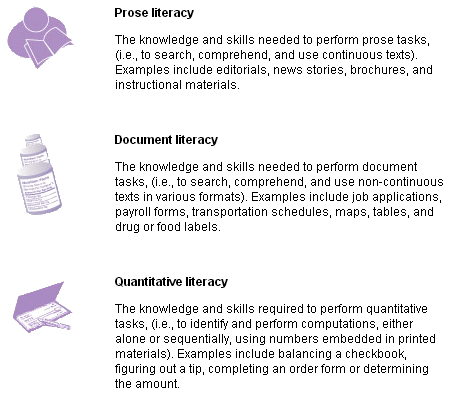Access to education is only the first step. Education for all must be learning for all. It is important to assess a nation's literacy level in order to gauge accurately and properly both needs and current human capacity of a country. To this end, levels of literacy must be clearly defined against standards. These are measures that are only as good as the instruments or tools used. When a nation is supposed to be close to a 100% literacy rate, does this high rate actually agree with day-to-day observations? There are certainly different levels of literacy. My 4-year old daughter can recognize some letters now and my 6-year old son can read children's books. Are they going to be considered literate?
Wikipedia distinguishes between primary and functional illiteracy:
There are two different kinds of illiteracy:
- Primary illiteracy: People with primary illiteracy have never learned how to read or write.
- Functional illiteracy: People who have learned some reading and writing, but not well enough for their work. Perhaps they cannot write well enough to fill out a form, or to understand instructions in a manual.
The United States National Center for Education Statistics goes further by defining three different types of functional literacy in English:
And the results for the 1992 and 2003 surveys are summarized below:
 |
Above figure captured from Literacy in Everyday Life
Kutner, M., Greenberg, E., Jin, Y., Boyle, B., Hsu, Y., and Dunleavy, E. (2007).Literacy in Everyday Life: Results From the 2003National Assessment of Adult Literacy (NCES 2007–480). U.S. Department of Education. Washington, DC: National Center forEducation Statistics. |
|
|
|
And the following provides an overview of what abilities these levels of literacy entail:
 |
Above table captured from Literacy in Everyday Life
Kutner, M., Greenberg, E., Jin, Y., Boyle, B., Hsu, Y., and Dunleavy, E. (2007).Literacy in Everyday Life: Results From the 2003National Assessment of Adult Literacy (NCES 2007–480). U.S. Department of Education. Washington, DC: National Center forEducation Statistics. |
It should be noted that the above literacy assessments are obtained independent of educational attainment. No assumption, for example, is made that a high school graduate must be at a particular literacy level. Thus, one can compare the literacy results against high school education, as shown in the following graph:
 |
Above figure captured from Literacy in Everyday Life
Kutner, M., Greenberg, E., Jin, Y., Boyle, B., Hsu, Y., and Dunleavy, E. (2007).Literacy in Everyday Life: Results From the 2003National Assessment of Adult Literacy (NCES 2007–480). U.S. Department of Education. Washington, DC: National Center forEducation Statistics. |
The basic levels are for prose, 210-264, for document, 205-249, and for quantitative, 235-289. The mean scores for all of the above therefore fall near this level in all three types of literacy. This basic level, with its description given above, parallels what
Wikipedia calls functional literacy. Since the above are only averages, looking at the entire data indicates that not all high school graduates in the United States are functionally literate. The following are the percentages of high school graduates not meeting the basic level: 13% (prose), 13% (document) and 24% (quantitative). Functional literacy in math seems to be the most challenging.
Seeing the statistics in the United States, it is equally interesting to examine the situation. The following is from the
2008 Functional Literacy, Education and Mass Media Survey of the Philippines:
First, it is important to note that in the Philippines, a high school graduate is assumed to be functionally literate. This is an important deviation from the assessment made in the United States. Almost a fourth of K-12 graduates in the US do not meet the basic level of quantitative literacy. In the Philippines, level 4 is simply defined as graduating from high school or having higher education. It should be noted that in the United States study, there are college graduates that likewise do not meet the basic level of functional literacy. Figuring out how the above levels in FLEMMS correspond to the levels in the US, it seems that Philippines' level 3 is equivalent to the basic level of functional literacy in the US. Another difference is that the US study includes only adults 16 years old or older while the Philippine study includes ages 10 through 64. Thus. it is important to look at the data distributed according to different age groups:
The percentages above correspond to being functionally literate at level two, which is below basic in the US scale. Nonetheless, even at this lower level, only 84% passes. With level three as the cutoff, 30% are in fact functionally illiterate (below the basic level in the US system) with the unfounded assumption that all high school graduates are functionally literate. Again, just to reiterate, as shown in the US study, adults who went through and graduated from the country's K-12 program are not necessarily functionally literate.
Nonetheless, Albert, Quimba and Ramos in "
Why are some Filipino children not in school?" try to make some sense out of this:
The above basically shows that school attendance influences functional literacy. Out-of-school children are twice more likely to be functionally illiterate than children who remain in school. Albert et al. then make the connection between out-of-school children, poverty level and educational attainment of the mother:
The above observations have been highlighted by a previous study of Albert, as described in a previous article in this blog, "
Out-of-School Children in the Philippines". That article emphasizes the factors seen as influential in causing children to drop out from school. First, there is a correlation between child labor and the adjusted net attendance rate. Second, children who are leaving school are predominantly poor. Third, the number of out-of-school children in the Philippines is correlated with the educational attainment of the mother.
Looking at how functional literacy is evaluated and measured in the Philippines, however, raises additional questions. The Philippines seems to be trying to paint a rosier picture.








Comments
Post a Comment